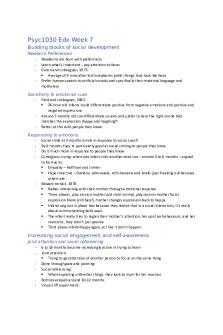AED1260- Lecture notes WK 4-7 PDF

| Title | AED1260- Lecture notes WK 4-7 |
|---|---|
| Author | Jessica Stapleton |
| Course | The Arts in Education |
| Institution | Edith Cowan University |
| Pages | 3 |
| File Size | 38.5 KB |
| File Type | |
| Total Downloads | 16 |
| Total Views | 150 |
Summary
Download AED1260- Lecture notes WK 4-7 PDF
Description
AED1260 – Lecture 4 Process Drama Encourage children to be creative thinkers - New ideas - No judgement - Problems to solve Drama (what if) - Anything, anywhere What is it? - Form of improvisation - Pre-text - Unscripted drama - Students might think beyond their P.O.V Teacher will - Select pre-text - Help students select roles - Frame the drama - Sequencing scenes Teacher in role - Organize children’s drama from the inside - Adopted character to guide the drama - Triggering device – clothes (teacher in role) Questions Who are we? What are we doing? Where are we? Why are we here? Conflict (drives the drama) Pre-text - Foreshadows/goes back to the past - Determines first moment Suspend ending disbelief Chair- hot seat in role and questioned.
AED1260- Lecture 5 Drama Classroom- some structure, committed to the process of risk + freedom Space- Location, size, internal restrictions, heating, cooling, ventilation, safety, PowerPoints. Controlled space- “freeze” Sit out but don’t talk to other students. Normal classroom behaviour at all times. Flexible lesson format - Warm up - Focus of the lesson - The wind down Evaluate, why? how?, how will you know? AED1260 – Lecture 6 Play building The process of creating your own play - Working as a team - Needs characters/mood 1. Choose a topic 2. Generate ideas 3. Find a symbol 4. Establish Identities Drama games Improvisation Hot seat Tableaux Sculpting Mime Movement Choral speaking Improvise beginning + end scenes - Plot plan, rest of play. Triggers - Subtract, simplify - Combine, extend - Empathize, extract - Animate, parody - Superimpose Allow time Reflect on story Listen to each student Provide a safe environment Characterisation Age
Walk, sit, use hand movements Voice, talk Personality type Prop or item of clothing What does the audience see? - Performers movements - Storyline, theme, topic - Aesthetics principles of composition Media Arts Wk7 - Creation - Interruption - Media language - Audience, constraints - Media “constructed” Three stages 1. Pre- production (sketching, storyboarding) 2. Production 3. Post- production Technical camera shots angles, sequencing +editing images to support particular purposes. Symbolic manipulating places, natural light, making meaning out of body language, costumes, props to represent people. Audio (loudness, softness, music to convey mood, sound effects) Written ( selecting, arranging of text, editing text , engaging an audience) Making - Editing - Recording - Digital cameras - Recording radio plays - PowerPoint - Video - Claymation Responding Why? What? Skill based apps - Focus on building a particular skill - Evergreen- more flexible promotes higher order skills - Sandbox apps- open-ended creative...
Similar Free PDFs

AED1260- Lecture notes WK 4-7
- 3 Pages

Torts WK 2 - lecture notes
- 8 Pages

Special Senses - Lecture notes 1-47
- 47 Pages

S.47 oapa - Lecture notes 5
- 2 Pages

LLB203 Wk 7 L - Lecture notes 7
- 14 Pages

Wk 1 Samsung - Lecture notes 1
- 17 Pages

COR109 WK 1-12 Lecture Notes
- 7 Pages

WK 10 Pharm 2 PDF - LECTURE NOTES
- 29 Pages

ACCG2002 Wk 1 - Lecture notes 1
- 3 Pages

Wk 1 Economics Lecture
- 1 Pages

TLEP lecture wk - Slides
- 1 Pages

Music Notes Wk #7
- 4 Pages

HIT 213 wk 7 lecture
- 1 Pages
Popular Institutions
- Tinajero National High School - Annex
- Politeknik Caltex Riau
- Yokohama City University
- SGT University
- University of Al-Qadisiyah
- Divine Word College of Vigan
- Techniek College Rotterdam
- Universidade de Santiago
- Universiti Teknologi MARA Cawangan Johor Kampus Pasir Gudang
- Poltekkes Kemenkes Yogyakarta
- Baguio City National High School
- Colegio san marcos
- preparatoria uno
- Centro de Bachillerato Tecnológico Industrial y de Servicios No. 107
- Dalian Maritime University
- Quang Trung Secondary School
- Colegio Tecnológico en Informática
- Corporación Regional de Educación Superior
- Grupo CEDVA
- Dar Al Uloom University
- Centro de Estudios Preuniversitarios de la Universidad Nacional de Ingeniería
- 上智大学
- Aakash International School, Nuna Majara
- San Felipe Neri Catholic School
- Kang Chiao International School - New Taipei City
- Misamis Occidental National High School
- Institución Educativa Escuela Normal Juan Ladrilleros
- Kolehiyo ng Pantukan
- Batanes State College
- Instituto Continental
- Sekolah Menengah Kejuruan Kesehatan Kaltara (Tarakan)
- Colegio de La Inmaculada Concepcion - Cebu


